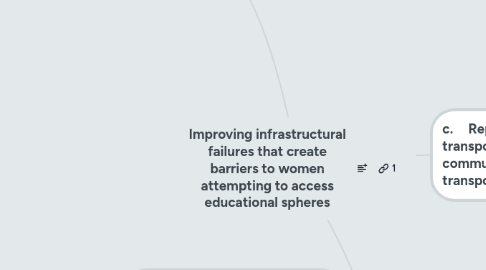
1. a. Creating regional sub-units to analyze infrastructural crises and failures within the region, concentrating on
1.1. i. Transportation methods that are frequently threatened by conflict
1.1.1. Transportation sustainability and quality of life
1.1.1.1. Linda Steg, Robert Gifford, Sustainable transportation and quality of life, Journal of Transport Geography, Volume 13, Issue 1, 2005, Pages 59-69, ISSN 0966-6923, https://doi.org/10.1016/j.jtrangeo.2004.11.003.
1.2. ii. Communities lacking easily accessible water resources
1.2.1. Water, sanitation, and hygiene (WASH) in schools are important for child health, development, and educational performance
1.2.1.1. Improving water, sanitation, and hygiene in schools in Indonesia: A cross-sectional assessment on sustaining infrastructural and behavioral interventions
1.2.1.2. Andrew J. Karon, Aidan A. Cronin, Ryan Cronk, Reza Hendrawan, Improving water, sanitation, and hygiene in schools in Indonesia: A cross-sectional assessment on sustaining infrastructural and behavioral interventions, International Journal of Hygiene and Environmental Health, Volume 220, Issue 3, 2017, Pages 539-550, ISSN 1438-4639, https://doi.org/10.1016/j.ijheh.2017.02.001.
1.3. iii. Food insecure communities
1.3.1. Evolving conceptualization of food security and of mechanisms to attain and maintain food security
1.3.1.1. Christopher B. Barrett, Chapter 40 Food security and food assistance programs, Handbook of Agricultural Economics, Elsevier, Volume 2, Part B, 2002, Pages 2103-2190, ISSN 1574-0072, ISBN 9780444510792, https://doi.org/10.1016/S1574-0072(02)10027-2.
2. b. Working with NGOs to respond to reported infrastructural needs within the area
2.1. i. Global Housing Foundation
2.2. ii. Centre NGO
2.3. iii. Habitat for Humanity
3. c. Repair roadways and transportation in indigenous communities to provide for safe transportation to schools
3.1. i. This work encourages the more use of public transport over private vehicles so as to save environment, energy and resources by suggesting improvement in infrastructure of bus services.
3.1.1. Rajput P., Toshniwal D., Agggarwal A. (2017) Improving Infrastructure for Transportation Systems Using Clustering. In: Reddy P., Sureka A., Chakravarthy S., Bhalla S. (eds) Big Data Analytics. BDA 2017. Lecture Notes in Computer Science, vol 10721. Springer, Cham. Improving Infrastructure for Transportation Systems Using Clustering
